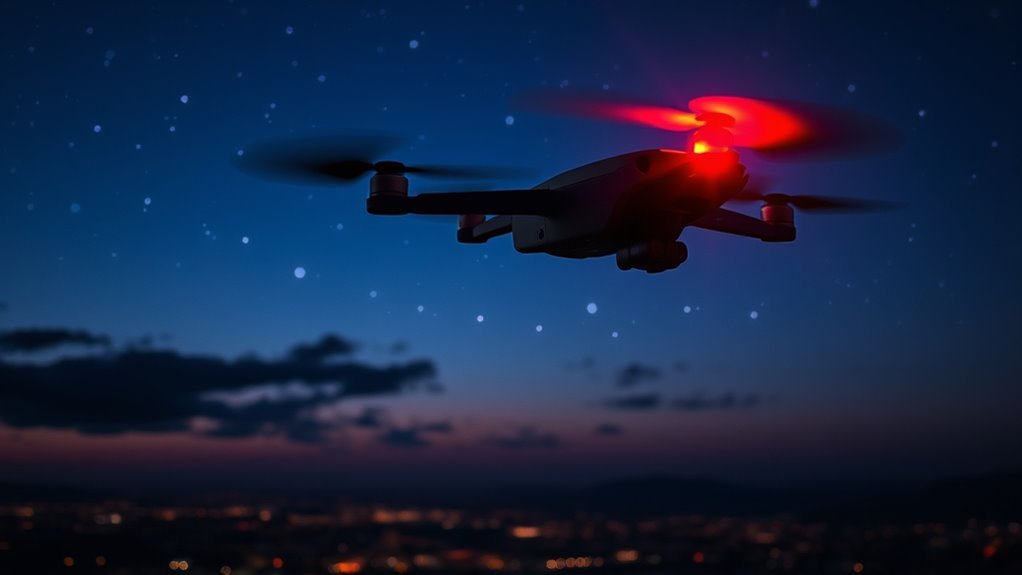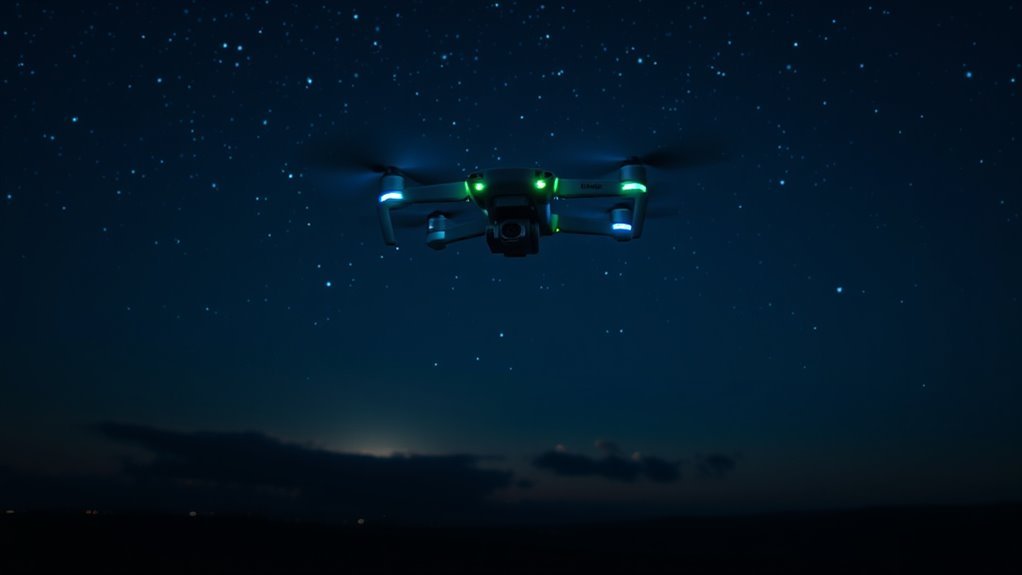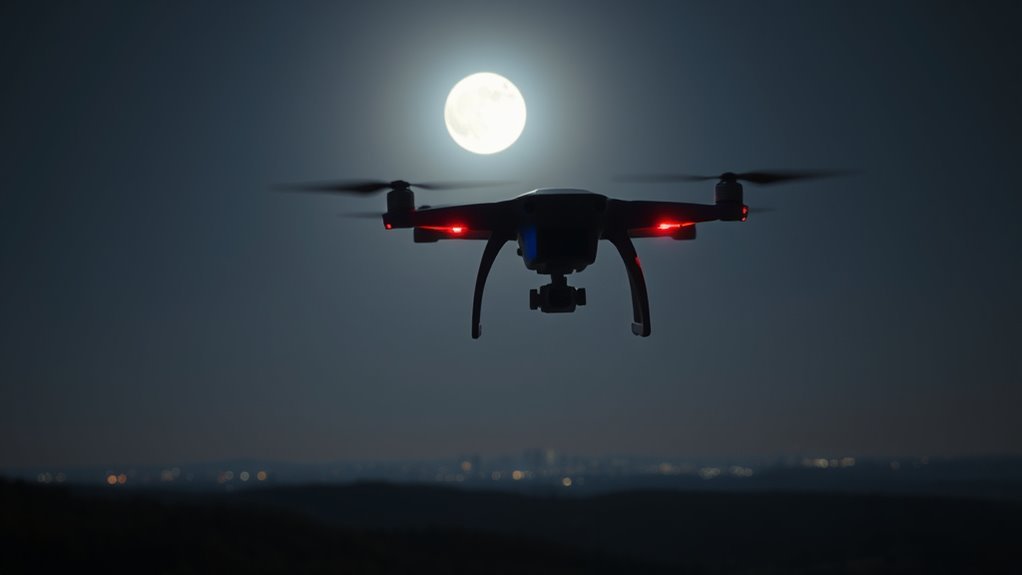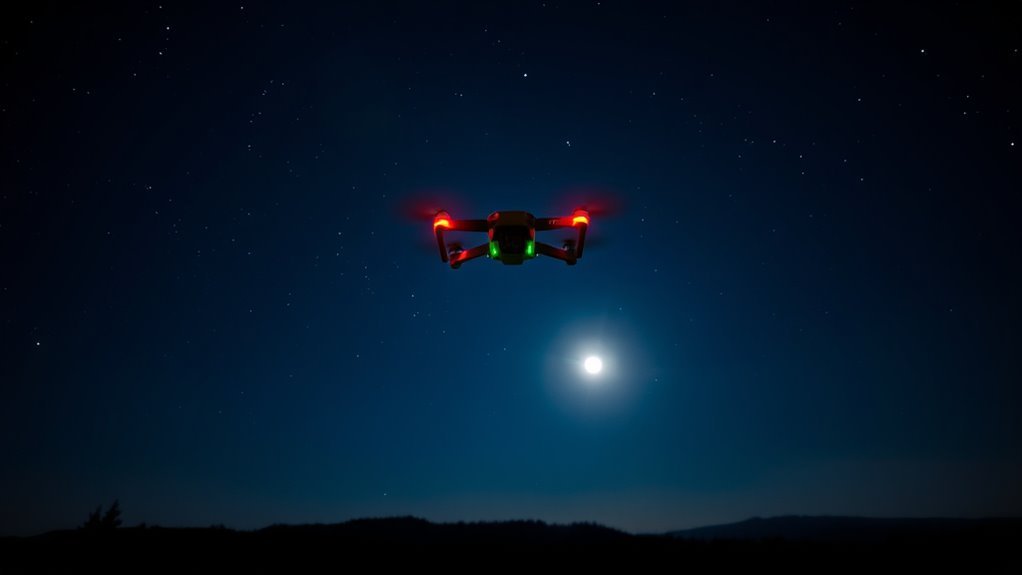Yes, you’re allowed to fly drones at night, but you must follow FAA regulations. Your drone needs proper lighting, including anti-collision lights visible from at least three statute miles. You’ll also need to maintain line of sight and stay below 400 feet while avoiding restricted airspace. Additionally, local laws may impose extra restrictions. Understanding these rules is essential for safe and legal nighttime flying, and there’s more to take into account for a successful night flight.
Understanding FAA Regulations for Nighttime Drone Flights

When you’re considering flying drones at night, it’s essential to understand the FAA regulations that apply. To guarantee safety and compliance, you must maintain adequate nighttime visibility. This means your drone must be equipped with proper drone lighting, including anti-collision lights that are visible from a distance. The FAA requires these lights to help you and others see the drone in low-light conditions, enhancing safety for both the operator and the public. Additionally, you’ll need to comply with the general guidelines for flying during the night, such as staying below 400 feet and avoiding restricted airspace. By adhering to these regulations, you can enjoy the freedom of nighttime drone operations while guaranteeing safety and compliance.
Equipment Requirements for Flying Drones at Night

Understanding the FAA regulations for nighttime drone flights sets the stage for the necessary equipment you’ll need. To fly legally and safely after dark, your drone must have adequate drone lighting. This includes lights that are visible for at least three statute miles, allowing other aircraft to see your drone. Additionally, consider investing in night vision goggles or compatible equipment, which can greatly enhance your ability to operate in low-light conditions. These devices help you maintain situational awareness and navigate effectively. Always check that your drone’s lighting system is functioning properly before each flight. By ensuring you have the right equipment, you can enjoy the freedom of nighttime flying while adhering to regulations and promoting safety. It’s also important to be aware of federal oversight when operating your drone to avoid any legal issues. Furthermore, local regulations may impose additional restrictions on nighttime flights, so it’s essential to stay informed.
Safety Considerations When Flying Drones After Dark

Although flying drones at night can be exhilarating, safety must remain a top priority. Increased darkness can lead to significant flight hazards, so it’s essential to take specific precautions to guarantee a safe experience. Here are some key considerations:
- Enhance Nighttime Visibility: Use lights on your drone to improve visibility and help you keep track of its position. Drones equipped with advanced camera capabilities can also assist in capturing clearer images in low light.
- Pre-Flight Planning: Familiarize yourself with the area and identify any potential obstacles or hazards before takeoff.
- Maintain Line of Sight: Always keep your drone within visual range to avoid losing control and guarantee safe navigation.
- Monitor Weather Conditions: Be aware of weather changes that could affect visibility and flight stability. Additionally, consider utilizing drones with advanced camera capabilities to capture clear visuals even in low-light conditions.
Local Laws and Restrictions on Nighttime Drone Use
Before you take to the skies at night, it’s crucial to familiarize yourself with local laws and restrictions governing nighttime drone use. Different regions have varied local drone regulations that dictate whether you can fly after dark. In many areas, you’ll need specific nighttime flight permissions from authorities, which often require additional safety measures like equipping your drone with proper lighting. Failing to comply with these regulations can lead to hefty fines or even confiscation of your drone. To guarantee you’re flying responsibly and legally, check with your local aviation authority or consult community guidelines. Understanding these local rules not only protects your freedom to fly but also helps maintain safety in your airspace. Additionally, adhering to local ordinances ensures that you respect the boundaries set for drone operations in your area.
Tips for Capturing Stunning Nighttime Aerial Photography
Once you’re aware of the local regulations for flying drones at night, it’s time to focus on how to make the most of your nighttime aerial photography. Here are some tips to elevate your shots:
- Choose the Right Camera Settings: Set a low ISO for less noise and a slower shutter speed to capture more light.
- Utilize Creative Lighting: Use external lights or your drone’s built-in lights to create striking contrasts and highlights. Additionally, ensure your drone has a high-quality camera performance to achieve sharp and vibrant nighttime images.
- Plan Your Composition: Scout locations with interesting landscapes or cityscapes; foreground elements can add depth.
- Stabilize Your Drone: Use a gimbal or choose a stable flight mode to minimize movement during long exposures.
Additionally, ensure your drone is equipped with advanced night vision technology to enhance clarity in low-light environments.
With these strategies, you’ll harness the beauty of nighttime settings effectively.
Frequently Asked Questions
Can I Fly Drones at Night Without a Part 107 Certification?
You can’t fly drones at night without a Part 107 certification. Night flying regulations require proper lighting for drone visibility, ensuring safety and compliance. Always check local laws before planning your night flights.
What Are the Penalties for Flying Drones at Night Illegally?
Flying drones at night without proper authorization can lead to heavy fines and penalties. The legal consequences might feel like a storm cloud, looming over your freedom, stifling your ability to explore the skies unencumbered.
Do I Need Additional Insurance for Nighttime Drone Flights?
You might need additional night flight insurance to guarantee adequate drone liability coverage. Standard policies often don’t cover nighttime operations, so check with your provider to avoid potential legal and financial complications during your flights.
Can I Fly Near Airports at Night?
When it comes to flying near airports at night, remember: “An ounce of prevention is worth a pound of cure.” You’ll need to adhere to airport regulations for night operations to guarantee safety and compliance.
Are There Specific Night Flying Drone Clubs or Communities?
Yes, there are specific night flying drone clubs and communities for drone enthusiasts. These groups often share tips, host events, and provide a supportive environment, allowing you to connect and enjoy nighttime flying responsibly.

